Are you thinking about getting into gardening in the heartland state of Nebraska? With huge temperature fluctuations from summer to winter, Nebraska can be a difficult state to find flowering plants that are hardy enough to grow. Let us help you create a beautiful perennial garden that not only withstands Midwest’s fluctuating weather conditions but thrives in it. This guide will provide you with a handful of resilient, vibrant, and enduring flowers that promise to return each year, making your garden a perennial paradise.
Let’s unveil the best perennial flowers for Nebraska: here are 14 flowers you can count on coming back!
What Is Nebraska’s Climate?
Nebraska is a landlocked state in the Midwest with characteristically warm summers and cold winters. It also has a relatively dry climate, with drought being common. The state has intense weather and temperature fluctuations. During the winter, massive snow flurries and blizzards often occur, and during drought, dust storms or tornados may occur.
What Usda Hardiness Zone Is Nebraska In?
Nebraska is in USDA Zones 4a, 4b, 5a, and 5b. The minimum temperature in winter for these zones is between -30 degrees and 10 degrees Fahrenheit. Plants in this hardiness zone are far from tropical and must be able to withstand frigid temperatures. Plants must be able to handle frost for most months of the year. All perennials we have included in this list can handle USDA zones 4 or 5.
1. Fragrant Sand Verbena (Abronia fragrant)

This lavender-colored flower is very hardy and can survive in Nebraska’s harsh climate.
©Mary Prentice/Shutterstock.com
The fragrant sand verbena is a pleasantly aromatic perennial plant that takes an upright or sprawling form. It’s known for its striking snowball-like clusters, which are approximately 3 inches in diameter, each filled with 25 to 70 funnel-shaped blooms. These flowers, with their inviting vanilla scent, come into bloom from spring to early fall and display an array of colors – commonly white, but occasionally lavender, green or pink.
These scented blossoms are a magnet for butterflies and elegantly tower over the plant’s shiny, green foliage that’s characterized by its rippled edges and fuzzy texture. It’s an excellent choice for a conspicuous groundcover, rock garden decoration, or a border highlight in perennial gardens.
It thrives under partial shade in sandy, dry, and well-draining soils. Plus, it’s a drought-resistant plant, making it a durable choice for Nebraska gardens.
2. Anise Hyssop (Agastache foeniculum)
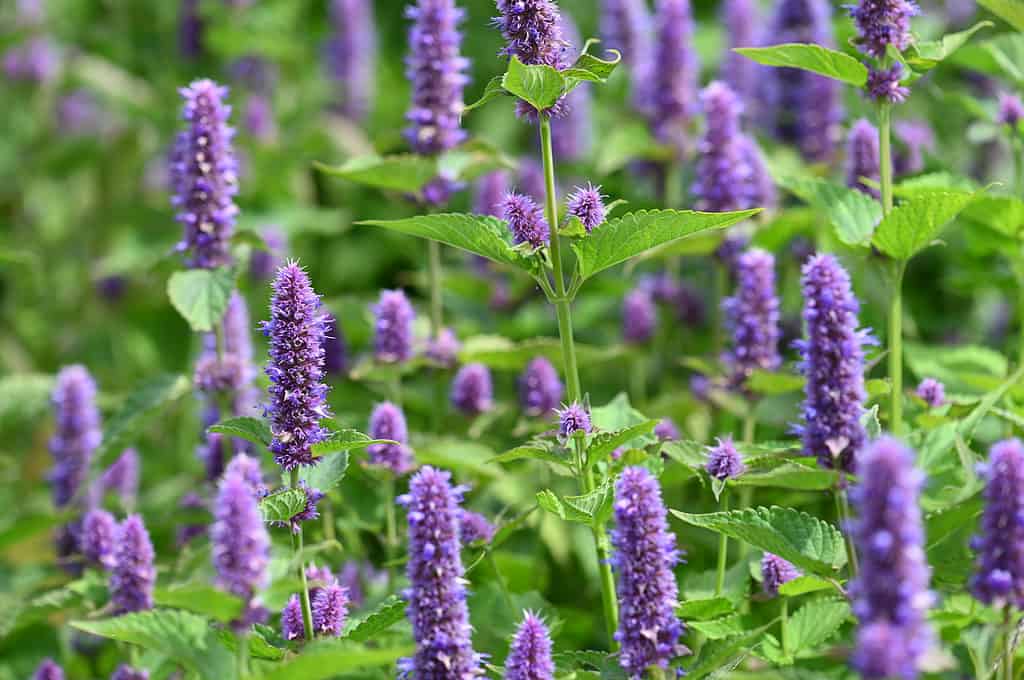
A plant in the mint family, a major attraction for pollinators in Nebraska, is Anise hyssop.
©iStock.com/BethAmber
Anise hyssop stands as an erect, clump-arranged perennial with appealing spikes adorned with tiny, tube-shaped flowers that are either lavender or purple. These flowers appear from the early summer until the beginning of fall, introducing beautiful vertical elements into the landscape. They’re also a magnet for bees, hummingbirds, butterflies, and other beneficial insects.
This plant perfectly suits informal landscapes, herb and butterfly gardens, or even meadows. For a charming touch, you can also include its floral spikes in fresh bouquets or dry arrangements.
In terms of growing conditions, anise hyssop does well in full sun or partial shade and in average, dry to moderately moist, well-draining soils. Once established, it displays impressive drought tolerance.
3. Pacific Anemone (Anemone multifida)
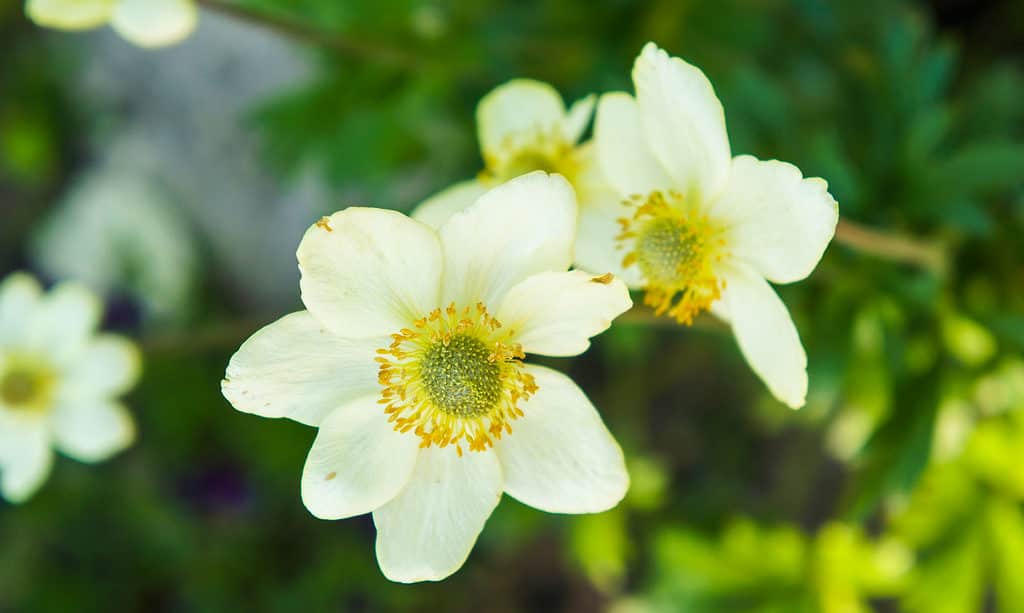
Another beautiful perennial for Nebraska is the Pacific anemone flower.
©iStock.com/skymoon13
Pacific anemone is a perennial herb that grows in relaxed clusters of thin, silk-like stems covered with downy, finely sliced leaves with long petioles. From late spring to late summer, you can expect to see unique, silky, poppy-resembling flowers sprouting atop these stems. These individual blooms, about an inch in diameter, display varying hues of green, yellow, or purple on the exterior and a yellowish-white inside.
Post-bloom, they give way to silky, pinkish seedheads, which hummingbirds then use to construct their nests. This North American variety is an easy-to-grow anemone and is a wonderful choice for rock gardens or border fronts due to its petite size.
Preferring part shade, this type of anemone flourishes in moist, gravel-rich, and well-draining soils.
4. New England Asters (Symphyotrichum novae-angliae)

A native perennial to the USA that thrives in Nebraska is the New England aster, which has purple, daisy-like flower buds.
©iStock.com/McKinneMike
The New England aster is among the tallest and most visually impressive asters. This sturdy, upright perennial is well-known for its abundance of showy, daisy-like flowers. Each bloom is around 1.5 inches wide and features rose-purple rays that beautifully frame sunny yellow centers.
As a native North American species, it’s easy to care for, has a long lifespan, and provides a delightful splash of color during the fall.
For best growth, the New England aster prefers full sunlight and thrives in average, moderately moist, well-draining soils. Although it does prefer moist and fertile soils, good air circulation around the plant is essential to prevent leaf diseases like powdery mildew.
5. Sego Lily (Calochortus nuttallii)

A bulb perennial plant with a gorgeous white bloom is the sego lily.
©Kris Wiktor/Shutterstock.com
The sego lily is another perennial flower for Nebraska gardens that looks gorgeous. It is a bulb that produces one to three large, white or lavender-blue, tulip-like flowers on tall, thin stems from late spring to late summer. These gentle flowers, spanning up to 3 inches across, flaunt three large satiny petals with yellow bases and red accents alongside three narrower sepals.
Originally from the dry areas of the American West, the sego lily holds the honor of being the official state flower of Utah. Its survival in its native range has come under threat, and it now enjoys protected status, prohibiting picking or transplanting from the wild. Sego lilies are wildflowers, but they can also be cultivated in home gardens of Nebraska, provided their specific needs are met.
For optimal growth, this flower prefers full sun exposure and thrives in sandy or loamy, dry, well-draining soils. It needs very little water and can tolerate minimal rainfall, proving its drought resistance.
6. Giant Marsh Marigold (Caltha polypetala)
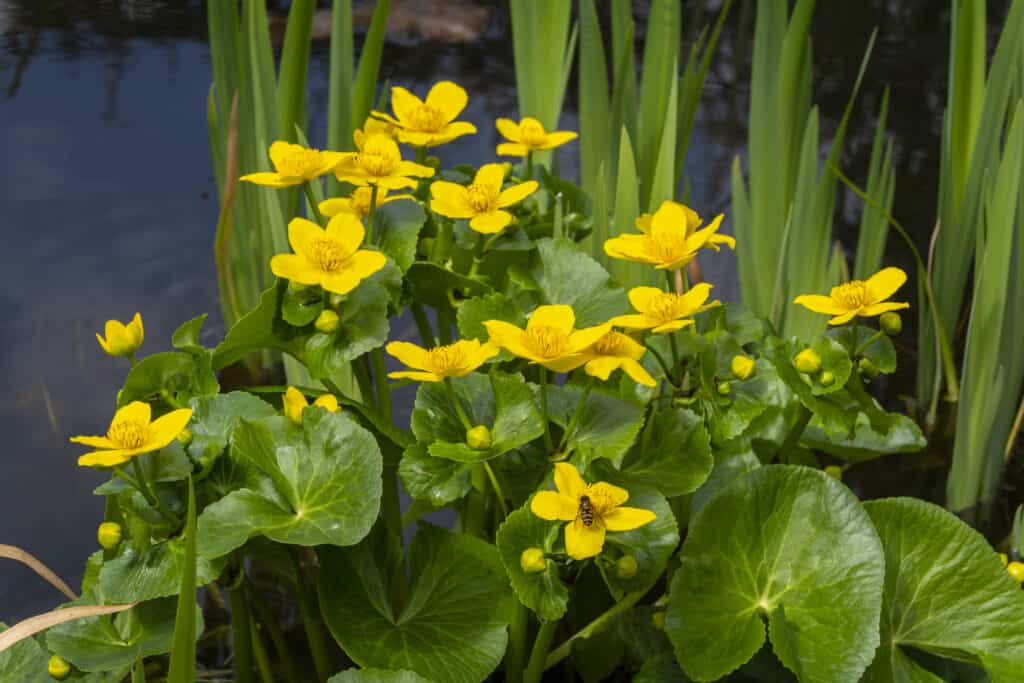
Giant marsh marigolds are often found in wetlands areas like marshes or along ponds.
©iStock.com/senatorek
With a striking resemblance to oversized buttercups, the giant marsh marigold is a herbaceous perennial that garners attention for its clusters of big, radiant golden flowers that can reach up to 2 inches in size. Up to 40 showy stamens further highlight these blossoms in their center.
The giant marsh marigold is among the first plants to bloom, marking the onset of the growing season with its vibrant flowers.
In terms of growing conditions, this plant does best under full sun in deeply nourished, rich organic soil. Being low maintenance and generally free of pests, it’s an excellent choice for Nebraska’s yards.
7. Cutleaf Toothwort (Cardamine concatenate)

Cutleaf toothwort is a perfect addition to a Nebraska garden.
©ForestSeasons/Shutterstock.com
Bringing a touch of early spring to woodland gardens, the cutleaf toothwort is a perennial plant that grows from rhizomes and boasts clusters of small, white, four-petaled flowers that sometimes bear a pink tinge. These blossoms appear from early to late spring, adding a delightful visual appeal.
Being quite hardy, cutleaf toothwort gradually spreads via its running rhizomes, eventually forming a beautiful natural carpet. This characteristic makes it an ideal choice for woodland gardens or any shaded areas where it can be left to spread and cover the ground naturally.
In terms of growth requirements, this plant thrives best in organically rich, humusy, moist, well-drained soils under partial shade.
8. Blue Mistflower (Conoclinium coelestinum)
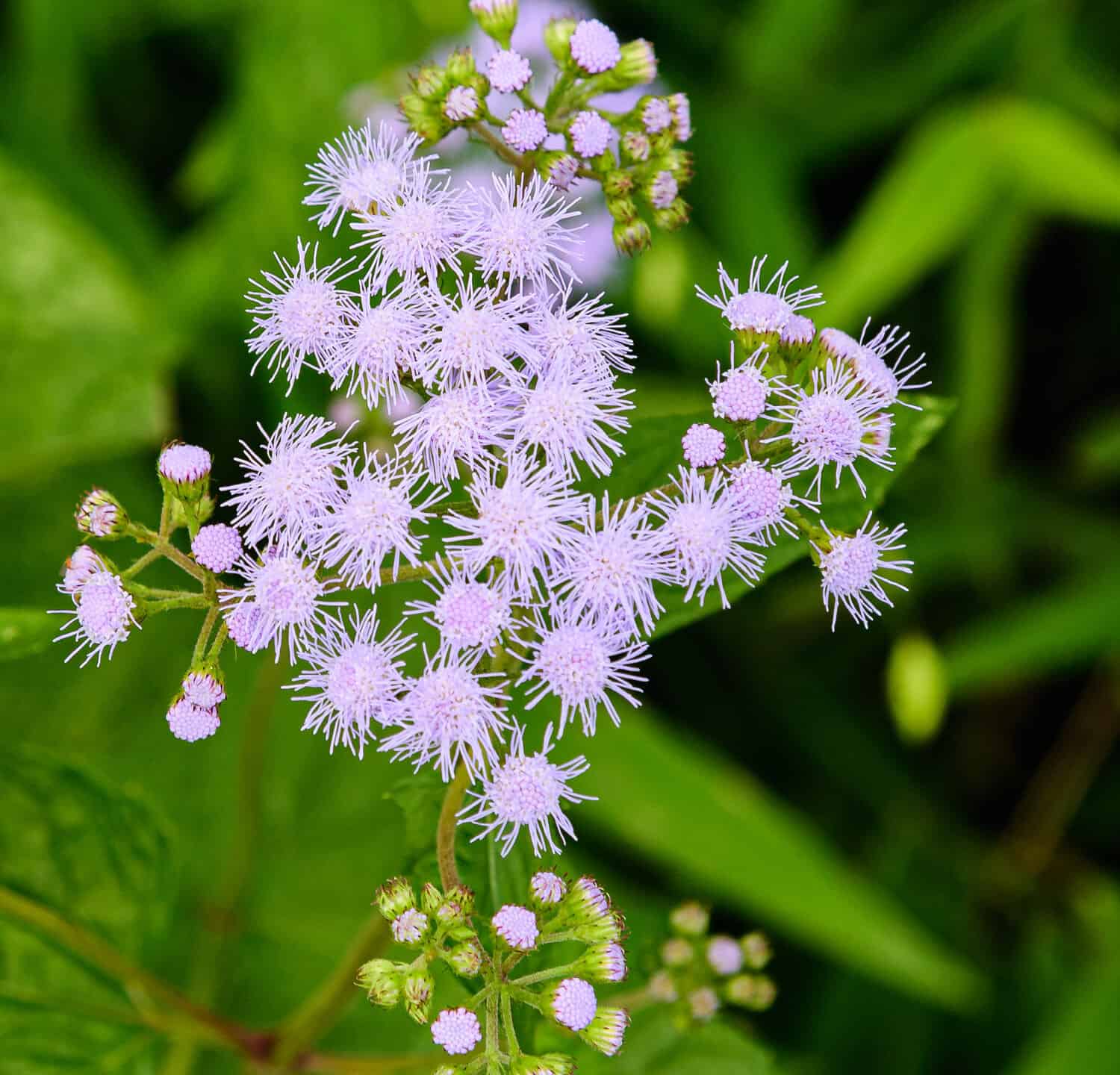
A perennial for Nebraska with a unique appearance is the blue mistflower, which draws many bees and butterflies.
©Bill Bass Photography/Shutterstock.com
The blue mistflower is an upright, expansive perennial famous for its profusion of small, fluffy, bright blue or purple flowers. These bloom in flat clusters from midsummer to late fall. Similar to ageratum blooms, these flowers grow on purplish stems and draw large numbers of bees and butterflies.
The blue mistflower brings a burst of color to the garden in the late season, a time when many other plants begin to lose their color. However, it’s worth noting that this wildflower spreads rapidly, which could potentially be troublesome.
For optimal growth, the blue mistflower prefers moist, fertile, humus-rich, well-drained soils, with exposure to full sun to partial shade. It’s also capable of tolerating wet soils.
9. Lanceleaf Tickseed (Coreopsis lanceolata)
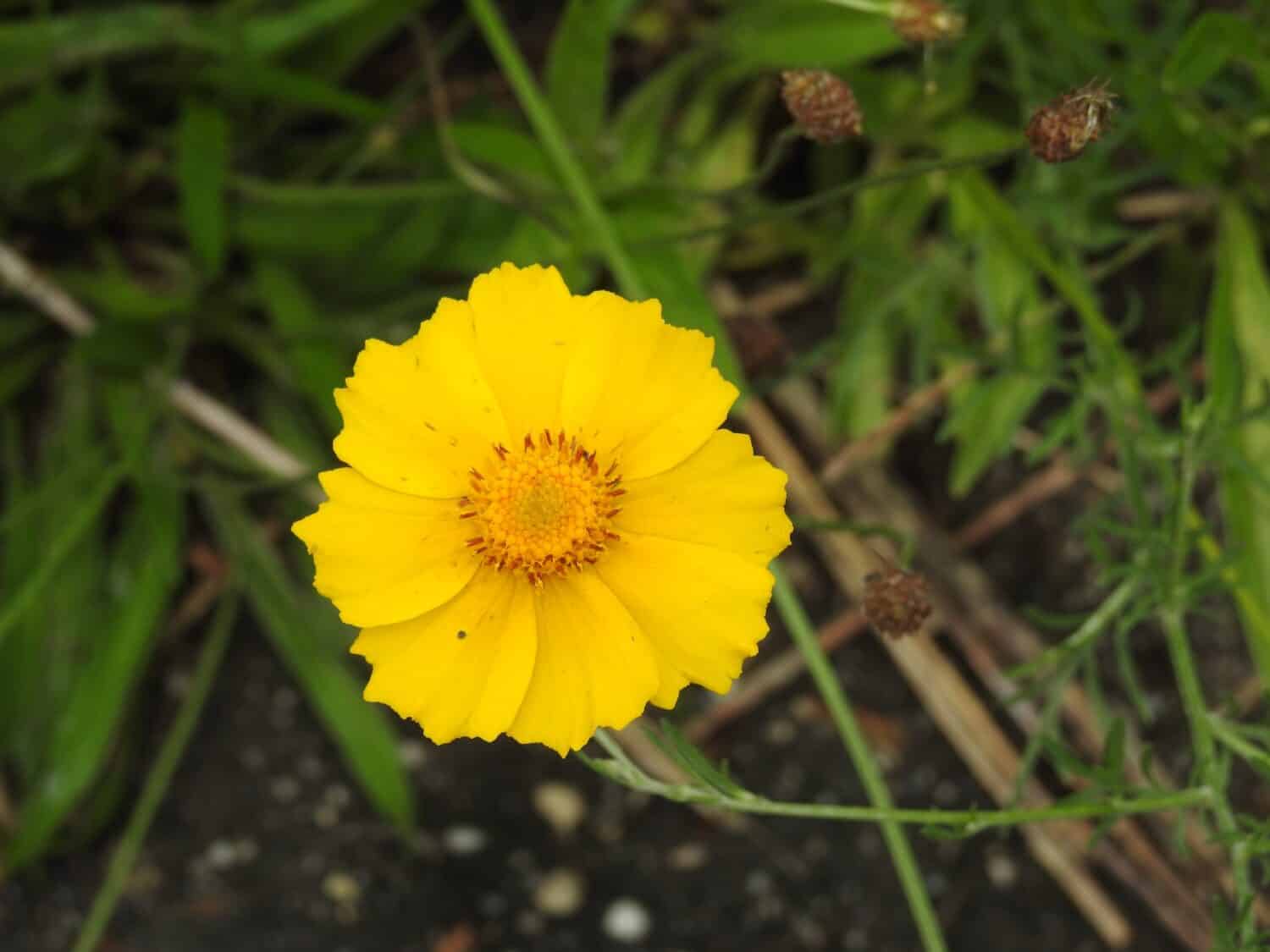
Lanceleaf tickseed looks a bit like a yellow daisy and can survive well as a perennial in Nebraska.
©Scenic Corner/Shutterstock.com
Originating from North America, the lanceleaf tickseed is a perennial plant known for its multitude of daisy-like yellow flowers. These blossoms, which measure up to 2 inches across, are characterized by their flat yellow center disks and bloom from late spring to midsummer. Each flower features 8 yellow rays that have a distinctive toothed appearance at their tips.
The lanceleaf tickseed is known for its resilience, tolerating heat, humidity, and drought, and proving itself as a solid performer in the garden. While it grows in small clusters, it can form extensive colonies over time.
This plant thrives in full sun and prefers dry to medium moisture, well-drained soils.
10. Dwarf Larkspur (Delphinium tricorne)

This flower adds subtle, purple tinges to your flower bed.
©Wirestock Creators/Shutterstock.com
The dwarf larkspur is a perennial plant that grows multiple stems, showcasing finely divided, palm-like leaves and loose clusters of 6-14 spurred flowers that come in shades of blue to dark purple. These flowers, which measure about 1 inch across, bloom sequentially along upright, fleshy stems during a 3-week period in mid to late spring.
In the springtime, the dwarf larkspur makes an impressive display in woodland gardens. When planted in groups, this plant creates an enchanting spectacle with its iridescent blue-purple flowers, resembling a bouquet!
This plant prefers full sun exposure, fertile, slightly alkaline, moist, and well-drained soils. It also benefits from some afternoon shade in areas with hot summer climates. Its characteristics make it a perfect addition to Nebraska’s perennial flower selection.
11. Dark Throat Shooting Star (Dodecatheon pulchellum)
The dark throat shooting star is another perennial flowering plant known for its clusters of 8-20 striking flowers that come in shades from brilliant magenta to deep cerise. These one-inch-long flowers resemble cyclamen blooms and feature 5 backward-curving petals each, beautified by a white collar at their base and a yellow ring. Just beneath the yellow ring, five stamens come together to form a downward-pointing beak.
This plant stands as one of the most stunning spring flowers in Nebraska and has even been recognized with the esteemed Award of Garden Merit from the Royal Horticultural Society.
To ensure its best growth, the dark throat shooting star prefers full sun to partial shade exposure and thrives in humus-rich, moist, and well-drained soils. It is advised to avoid areas with poor drainage and overly wet conditions, especially during winter months.
12. Western Goldentop (Euthamia occidentalis)
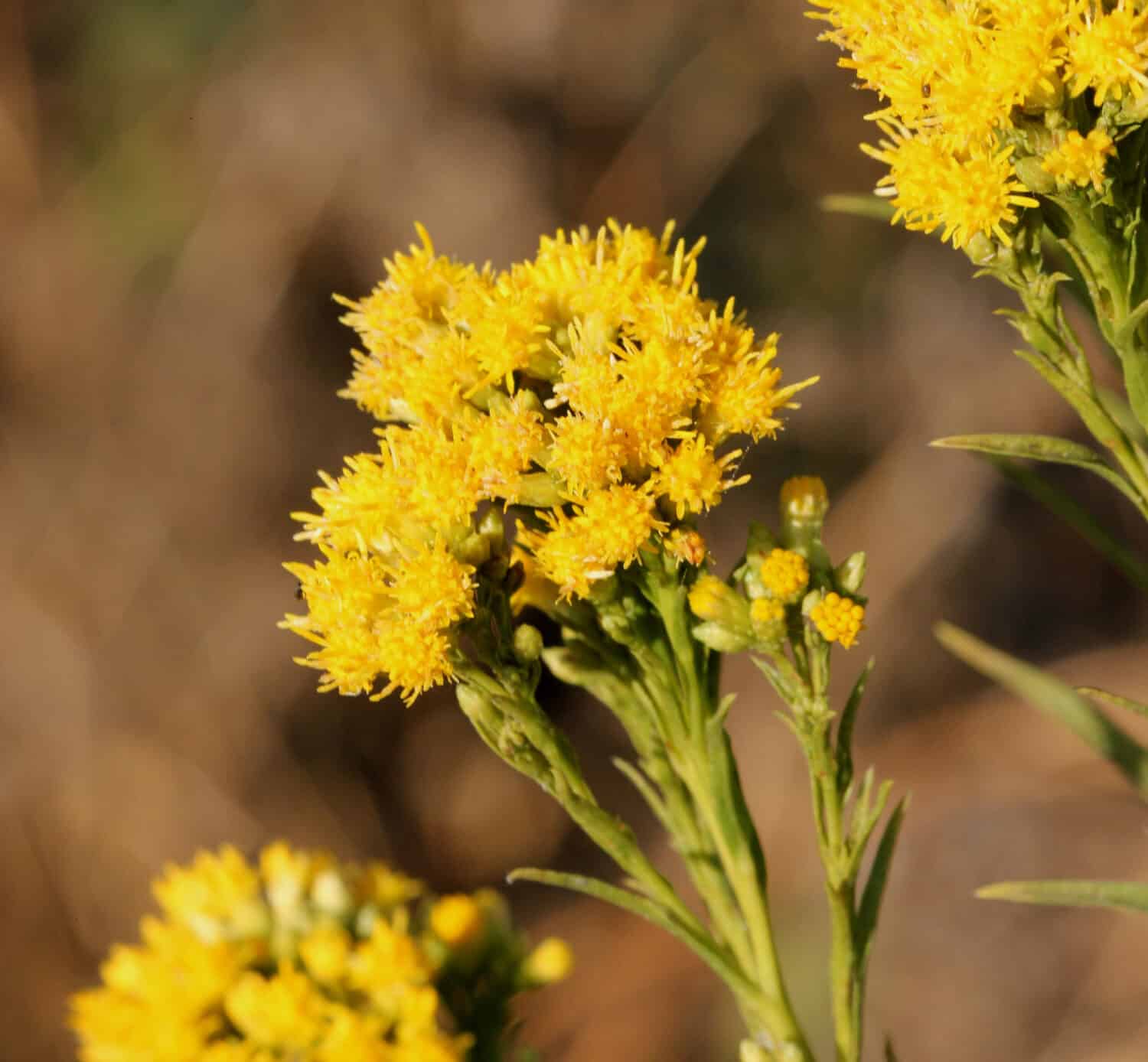
A common summer and fall flower in Nebraska is western goldentop.
©Gurcharan Singh/Shutterstock.com
Western goldentop grows from rhizomes, showcasing tall, branching stems adorned with elongated, narrow leaves in a gray-green hue. The plant’s blooming period spans from mid-summer through fall, during which it showcases dense clusters of yellow flowerheads, arranged in a flat-top pattern.
This plant serves as a nectar provider for various pollinators, such as bees and butterflies. Notably, it is recognized as a significant nectar source for monarch butterflies in the Rocky Mountain region.
The plant thrives best under full sun exposure and prefers moist, well-drained soils. It is also known to tolerate seasonal flooding, adding to its versatility in different garden settings.
13. American Lotus (Nelumbo lutea)

An awesome perennial addition to a pond for Nebraska is American lotus.
©Hernando Sorzano/Shutterstock.com
The American lotus is a striking aquatic perennial known for its large, umbrella-like leaves that span up to 2 feet. These leaves often rise above the water’s surface, making a grand display. During the summer, this plant features large, luminous yellow flowers that span up to 12 inches.
These blooms, carried on tall, rigid stalks that tower above the foliage, open each morning and close by late afternoon, maintaining a bloom period of about three days.
This aquatic marvel thrives under full sunlight and prefers organically rich soils that stay consistently wet. Its vibrant display and adaptability to Nebraska’s local conditions make it an ideal candidate for the list of best perennial flowers to cultivate in the region.
14. Prairie Ironweed (Vernonia fasciculata)
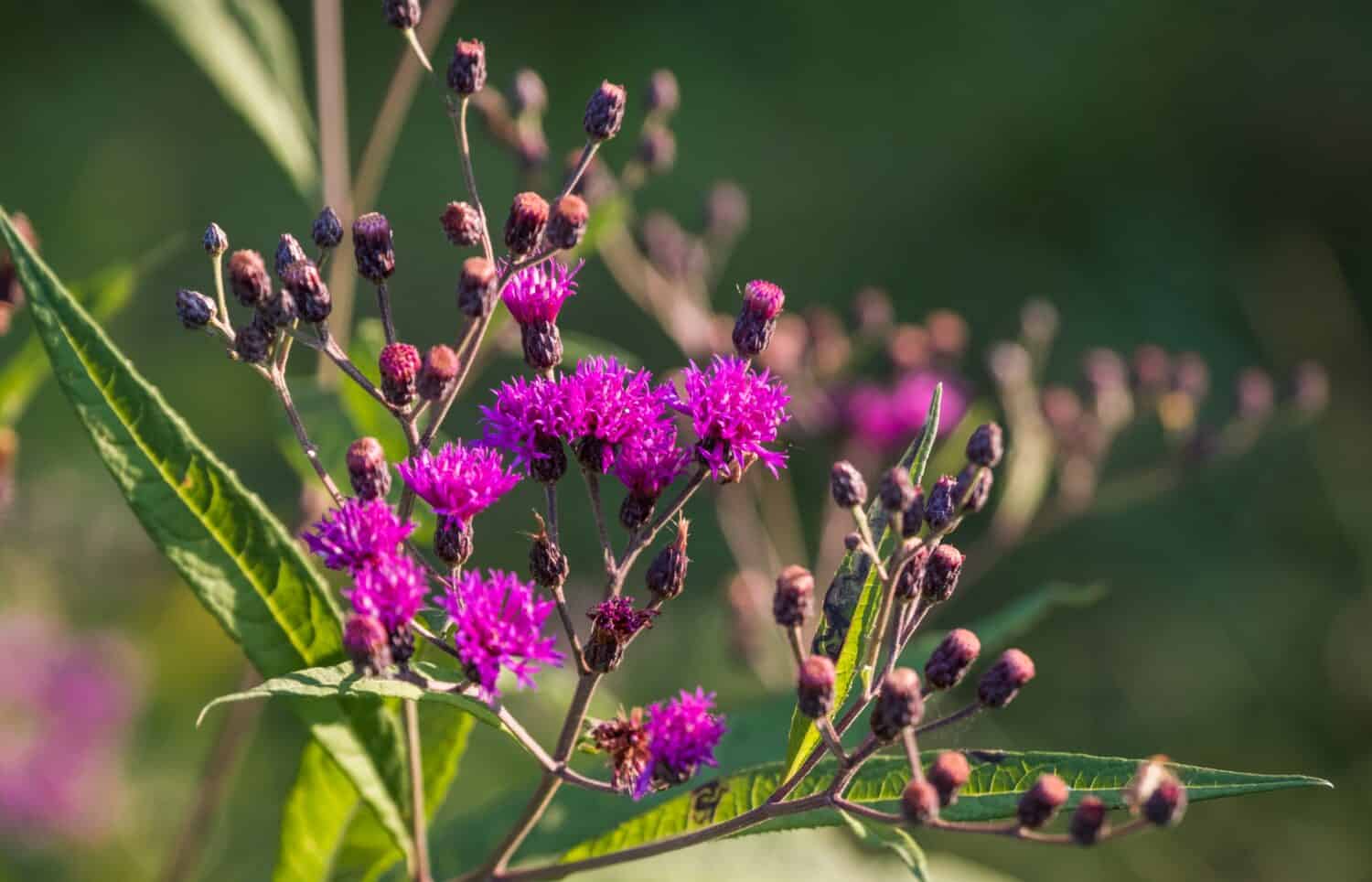
A common wildflower that can also be cultivated for gardens in Nebraska is prairie ironweed.
©LanaG/Shutterstock.com
Prairie ironweed adds a splash of color to gardens in Nebraska from mid-summer to early fall. It’s recognized by its dense clusters of small, feathery flowers that come in a vibrant shade of deep purple.
Although not known for aggressive growth, prairie ironweed can become somewhat invasive over time. It’s important to plant it thoughtfully, particularly in smaller gardens, to avoid overcrowding.
This flower shows its best growth under full sunlight in average soils that maintain medium to high moisture levels. It can also withstand temporary flooding during the seasons, making it a durable and attractive choice for Nebraska gardens.
Summary of the Best Perennial Flowers for Nebraska
| Flower | Blooming Period | When to Plant? |
|---|---|---|
| Fragrant Sand Verbena | Spring to early fall | Fall |
| Anise Hyssop | Early summer to early fall | Spring |
| Pacific Anemone | Late spring to late summer | Fall or early spring |
| New England Asters | Late summer to fall | Spring to early fall |
| Sego Lily | Summer | Early spring |
| Giant Marsh Marigold | Early spring to summer | Late fall or early spring |
| Cutleaf Toothwort | Spring | Late spring |
| Blue Mistflower | Midsummer to fall | Late fall |
| Lanceleaf Tickseed | Spring to early summer | Early spring |
| Dwarf Larkspur | Spring | Fall |
| Dark Throat Shooting Star | Late spring to summer | Late winter |
| Western Goldentop | Midsummer to fall | Fall to early spring |
| American Lotus | Summer to early fall | Early spring |
| Prairie Ironweed | Midsummer to early fall | Fall |
The photo featured at the top of this post is © Linhsiaowei/Shutterstock.com
Thank you for reading! Have some feedback for us? Contact the AZ Animals editorial team.







